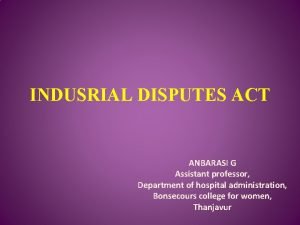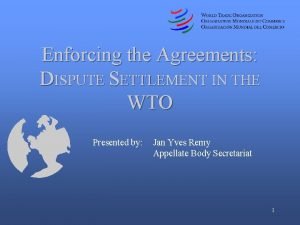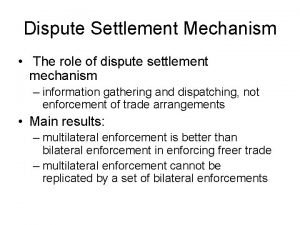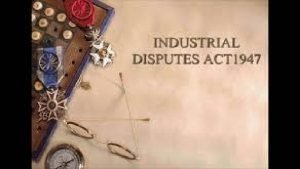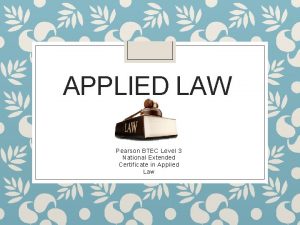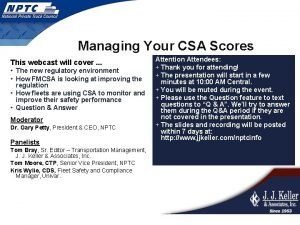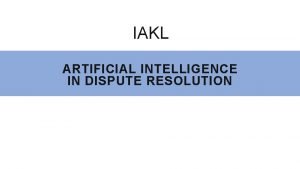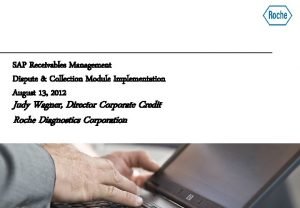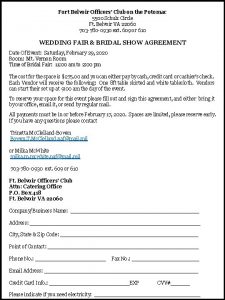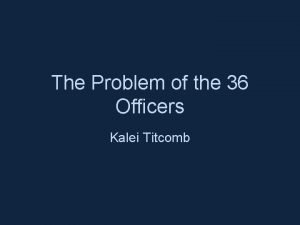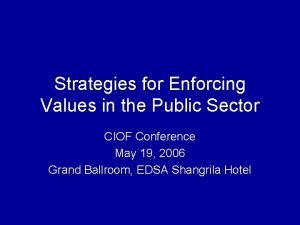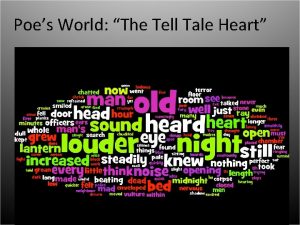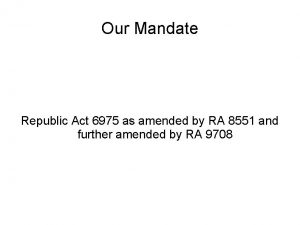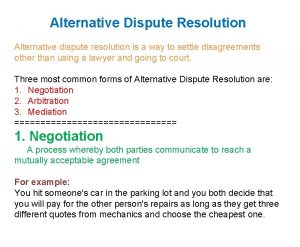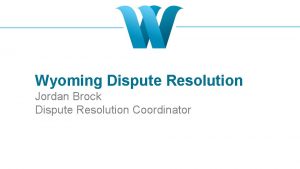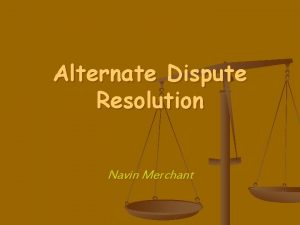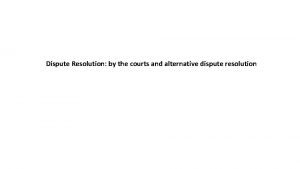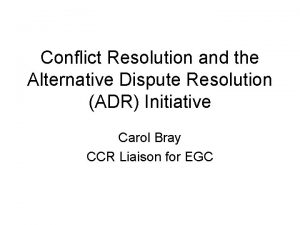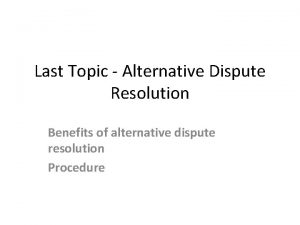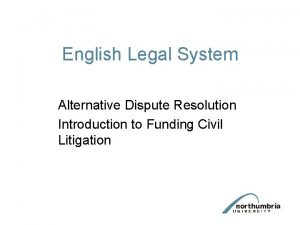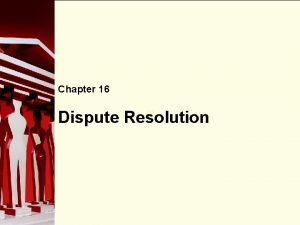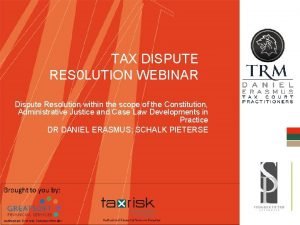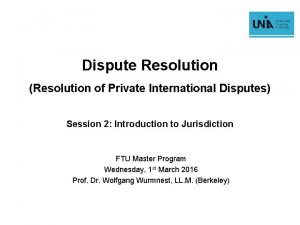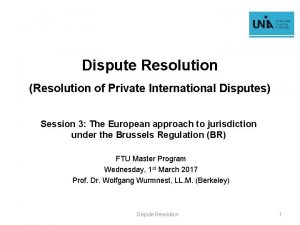ALTERNATIVE DISPUTE RESOLUTION Training for Legal Officers of
































- Slides: 32

ALTERNATIVE DISPUTE RESOLUTION Training for Legal Officers of the ECOWAS Community Court of Justice 11 th December, 2018 Facilitators ADEDAYO ADESINA & DAMILOLA LAWAL OYEWOLE & ADESINA

Training Agenda

Training Manual

OUTLINE Ø Introduction Ø Overview of ADR Ø ADR Methods Ø Negotiation Ø Mediation Ø Conciliation Ø Arbitration Ø Pros & Cons Ø Conclusion

LEGAL BRIEF WRITING Introduction § A brief is a written legal document used in various legal adversarial systems that is presented to a court, arguing why one party to a particular case should prevail. § A brief sets out the legal contentions of a party in litigation. § It is usually prepared by counsel as the basis for arguing a case, consisting of legal and factual arguments; the statutory and judicial authorities in support of them.

LEGAL BRIEF WRITING Introduction § A good legal brief helps to understand the case presented by a party to a suit. § It also helps in the quick dispensation of cases. See Muntaka Coomassie J. S. C. in Kabirikim v Emefor (2009) 14 NWLR (Pt. 1162) 602 at 634 § Good briefs make the work of the court easy and simple; unlike bad briefs which give the judges sleepless nights. Per Niki Tobi J. C. A (as he then was) in Weide & Co Nig Ltd v. Weide & Co. Hamburg (1992) 6 NWLR (Pt. 249) at 641

PRESIDENTIAL ENABLING BUSINESS ENVIRONMENT COUNCIL (PEBEC) ENABLING BUSINESS ENVIRONMENT SECRETARIAT ALTERNATIVE DISPUTE RESOLUTION Introduction It is almost inevitable in our world today that disagreements will occur from interactions and communications that take place in the course of general human relations and, in particular, the conduct of businesses. Email: info@ebes. gov. ng | Website: www. pebec. gov. ng | Twitter: @EBESnigeria | Facebook: www. facebook. com/EBESnigeria

PRESIDENTIAL ENABLING BUSINESS ENVIRONMENT COUNCIL (PEBEC) COMMENCEMENT OF ACTION ENABLING BUSINESS ENVIRONMENT SECRETARIAT Introduction Email: info@ebes. gov. ng | Website: www. pebec. gov. ng | Twitter: @EBESnigeria | Facebook: www. facebook. com/EBESnigeria

PRESIDENTIAL ENABLING BUSINESS ENVIRONMENT COUNCIL (PEBEC) COMMENCEMENT OF ACTION ENABLING BUSINESS ENVIRONMENT SECRETARIAT Introduction • These disagreements require the intervention of the judicial system to resolve them. • Hence, the need to create a legal framework whereby dispute resolution will be achieved with less cost and within the fastest time possible. Email: info@ebes. gov. ng | Website: www. pebec. gov. ng | Twitter: @EBESnigeria | Facebook: www. facebook. com/EBESnigeria

LEGAL BRIEF WRITING Purpose of Brief Writing § To put a client’s case forward in a summarized form. § To articulate cogent arguments to enable the court reach a decision. § To define issues arising in a case in order to narrow the scope of dispute between parties. § To advocate and convince the Judge/Arbiter to decide in favour of a party. § To curtail the time that would have been wasted in recording lengthy oral arguments. In Idundun v. Okumagba (1976) 9/10 S. C 227, oral arguments and submissions lasted for a period of 2 weeks.

LEGAL BRIEF WRITING Purpose of Brief Writing Contd. § Brief may also be used to articulate policy arguments and prevailing social circumstances. E. g where the law does not provide for an issue or is vague on an issue. § Brief writing is now the most used form of argument in court such that oral argument is now intended just to “amplify, articulate and highlight the main points in the brief, whenever necessary. ” – Per Nnaemeka-Agu J. S. C. in Onifade v. Olayiwela (1990) 7 NWLR (Pt. 161) 130 at 159

LEGAL BRIEF WRITING Types of Legal Briefs § Trial briefs are presented at trial to resolve a disputed point of evidence. § Legal briefs are used as part of arguing a pre-trial motion in a case or proceeding. § Amicus briefs refer to briefs filed by persons not directly party to the case. § Appellate briefs refer to briefs that occur at the appeal stage. Appellate briefs include Appellant’s Brief, Respondent’s Brief or Reply Brief. § Supplementary Brief is a brief filed in addition or supplementary to the main brief. The Rules of the Nigerian Courts do not provide for this. See Iwuaba v. Nwaosigwelem (1989) 5 NWLR (Pt. 123) 623 at 629.

LEGAL BRIEF WRITING Types of Legal Briefs § Memorandum of law may be another word for brief, although that term may also be used to describe an internal document in a law firm in which an attorney attempts to analyze a client's legal position without arguing for a specific interpretation of the law. § IRAC Case Briefs are usually a one page review done by a paralegal or attorney, ultimately used by the attorney to find previously decided cases by an appellate court in State or Federal jurisdiction, which shows how the courts have ruled on earlier similar cases in court.

LEGAL BRIEF WRITING Writing legal brief “Your brief should be a written argument with three missions: to win your case; to save the judge as much drudgery as possible in reaching his decision and to enhance your reputation as a lawyer. ” - Mortimer Levitan

LEGAL BRIEF WRITING Writing legal brief § No uniformat or structure for a brief. Rules of various courts define when and what type of briefs that can be filed at the court. § The Brief must take into account the following four (4) necessities of brief writing: ü Get the Judge’s attention. ü Assure the Judge that what you have to say will help in efficiently deciding the issue at hand. ü Show the Judge, vividly and memorably, the points you have to make. ü Leave the Judge with a conviction that the time spent with the brief is worthwhile.

LEGAL BRIEF WRITING Structural format of a good brief § A good brief must follow the following format: ü The Name of the Court in which the Brief will be argued ü The suit number ü Parties to the suit ü Title of the brief e. g Plaintiff’s Brief of Argument ü Table of Contents ü Preliminary objection (if any) for Respondent’s Brief ü Statements of Facts ü Issues for Determination ü The Argument ü Conclusion and Reasons ü List of Authorities ü Signature of Counsel preparing the Brief and Addresses for Service ü List of Counsel and Addresses for service

LEGAL BRIEF WRITING Writing legal brief § Familiarize yourself with the facts of the case ü Facts of a case are fundamental and an integral part of a brief. ü Know the facts of your case. Keep them at your finger tips. ü Master the evidence given at trial. “Here is a useful role for beginning: Know the story- as much of the story as you can possibly know, if not the whole story-before you commit yourself to the first paragraph. Know the story-the whole story, if possible-before you fall in love with your first sentence, not to mention your first chapter. ” – John Irving

LEGAL BRIEF WRITING Writing legal brief § Carry out in-depth research ü The heart and soul of a good brief is research. The quality of the argument is based on the depth of the research. ü Research on case laws, statutes, books, articles etc. ü As you do research upon the facts and the law, more and more ideas come to you. ü Jot down the ideas as they come to you. ü When you’ve finished your research, take time to think through your case.

LEGAL BRIEF WRITING Writing the legal brief § Organize and outline the brief “A brief must be carefully and thoroughly organised before it is written. There is nothing worse than a rambling document that sounds as if it had been dictated off the cuff and filed virtually without change. That kind of brief is difficult to follow, frequently repetitious, often internally inconsistent, and always unpersuasive. ” - Hon. Daniel M. Friedman ü It should be used to make topic headings to highlight each major point in brief. ü If the outline is faulty, the thinking is faulty. The outline invokes a sense of order to which the Judge will gravitate in crafting an opinion.

LEGAL BRIEF WRITING Writing the brief ü Frame/formulate the issues for determination and point headings. Ask yourself what questions the court must answer to dispose of the case in your client’s favour. ü Be sure you understand the concrete issues before you begin writing anything intended to go into the brief. ü It is safe to say that unless the author knows where he is going, very few readers will go along.

LEGAL BRIEF WRITING Writing legal brief § Write and compose a draft brief without stopping to edit. ü What you must do as a writer, is think about what to say and then let it flow the usual way. Afterwards, you will need to go over it and do some fixing. § Revise the brief, proofread carefully and also have others proofread the brief. “Clerical errors are unintentional mistakes made by anyone participating in the composition of a brief. . They are made by stenographers, typists, printers and lawyers. But whoever makes the error in the first place, the lawyer is responsible if it is not discovered and corrected before the brief is filed. ” – Robert L. Stern

LEGAL BRIEF WRITING The Persuasive Brief § The 90 Seconds Rule ü On the first page the Judge gets your stand on the basic question, your answer to that question, and the reasons for that answer. ü Framing the deep issue at the outset is a way of capturing judicial imagination. Whoever does that in a given case is most likely to win. A deep issue is the ultimate, concrete question that a court needs to answer to decide a point your way.

LEGAL BRIEF WRITING The Persuasive Brief § Framing issues for determination: To frame a good persuasive issue, a counsel must: ü Put it up front; ü Weave in enough facts so that the Judge can truly understand the problem; ü Write it in such a way that there is only one possible answer. Arrange the issues from most to least important, from the judge’s point of view.

LEGAL BRIEF WRITING The Persuasive Brief § Organise the argument section dialectically. thesis antithesis conclusion

LEGAL BRIEF WRITING The Persuasive Brief ü Begin and end with points in your favour. ü Begin the argument under each issue by supporting the legal and factual premises woven into the issue. ü Rebut and do harm to all serious counter arguments. § Make your points as simple as possible, but never oversimplify. ü Simplicity can be achieved by: using deep-issue technique, striving for shorter sentences, preferring the active voice, breaking up the text with headings, using bulleted lists etc.

LEGAL BRIEF WRITING The Persuasive Brief § Avoid repetition and slash unnecessary words. § Use complete-sentence point headings in the argument section. § Present important ideas in numbered or bulleted lists. § Never misstate the facts or the law. ü When you deal with the court, you must be candid, frank, straightforward, and aboveboard. § Answer your opponent’s arguments and flay them if possible. ü If an opponent has said something that seems compelling, you must quickly demolish that position to make space for your own argument.

LEGAL BRIEF WRITING The Persuasive Brief § State the facts dispassionately in chronological order. ü Facts must be stated in a logical and coherent order. ü By recreating the realistic relationship between facts, chronology generates an additional power of its own. ü Statement of facts should group items of evidence relating to a particular subject so that the court will readily grasp the whole picture. “While there are lots of ways to write a statement of facts, a good one passes two essential tests: First, it stands alone. Anyone reading your statement of facts should understand what the case is about without having to look at anything else. Second, the statement of facts should make the reader take your side. It should be persuasive without being argumentative. ” – James W. Mc. Elhaney

LEGAL BRIEF WRITING The Persuasive Brief § Marshall and discuss authorities with savvy and attention to detail ü Three basic types of supportive authorities – binding, persuasive and analogous but distinguishable. ü Many lawyers make the mistake of taking “useful language” from cases without considering how the cases were actually decided. ü Cobbling together arguments from cut-and-paste quotation is a dangerous enterprise. ü What matters is how the case turned out – If the party in the case analogous to your client fails – Don’t rely on the case. ü Never cite a case you haven’t read. ü In the absence of strong authority, analogize your case to parallel legal principles that apply similarly in an allied field – but do it with parity of reasoning.

LEGAL BRIEF WRITING The Persuasive Brief § Conclude powerfully. ü One way to conclude strongly is to capsulize the two or three or however many reasons why the court should do what you urge. ü Count the reasons and list them. Your argument will look substantial. “The conclusion in a brief is not just the major thing; it’s the only thing. It’s the only game in town. The purpose of a brief is to convince the court to accept your conclusion – to reverse, vacate, or affirm the lower court’s judgment. The only purpose of the brief’s contents that precede the conclusion-statement of jurisdiction, standards of review, issues, facts and the discussion of legal precepts-is to set the stage for logical premises to justify suggested conclusion. ” – Hon. Ruggero J. Aldisert

LEGAL BRIEF WRITING Conclusion A persuasive brief starts in the very first sentence with the problem in the case. The selection of the starting words always make the Judge want to read more. Email: info@ebes. gov. ng | Website: www. pebec. gov. ng | Twitter: @EBESnigeria | Facebook: www. facebook. com/EBESnigeria

LEGAL BRIEF WRITING

LEGAL BRIEF WRITING
 Msc in construction law
Msc in construction law Training officers consortium
Training officers consortium High resolution low resolution
High resolution low resolution What is labour law in india
What is labour law in india Krishna godavari dispute
Krishna godavari dispute Objectives of industrial dispute act 1947
Objectives of industrial dispute act 1947 Wto dispute settlement mechanism
Wto dispute settlement mechanism Dispute settlement mechanism meaning
Dispute settlement mechanism meaning Right dispute
Right dispute Objectives of industrial dispute act 1947
Objectives of industrial dispute act 1947 Maine vs canada war
Maine vs canada war Btec applied law
Btec applied law Antecedent boundary example
Antecedent boundary example Uces dispute letters
Uces dispute letters What is a relic boundary
What is a relic boundary How to dispute csa points
How to dispute csa points Dispute management ai
Dispute management ai Delay and dispute mitigation
Delay and dispute mitigation Sap receivable management
Sap receivable management Credit management in o2c
Credit management in o2c Bel retired officers association bangalore
Bel retired officers association bangalore Community college business officers
Community college business officers Ft belvoir officers club
Ft belvoir officers club Chief instructional officers california community colleges
Chief instructional officers california community colleges Chief instructional officers california community colleges
Chief instructional officers california community colleges Ifpo certified protection officer
Ifpo certified protection officer Uk chief medical officers' physical activity guidelines
Uk chief medical officers' physical activity guidelines 36 officers problem
36 officers problem Police officer pledge
Police officer pledge Tell tale heart annotations
Tell tale heart annotations R.a 6975
R.a 6975 What were the military duties of ranked officers othello
What were the military duties of ranked officers othello Canton police officers
Canton police officers





